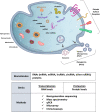Circulating platelets as liquid biopsy sources for cancer detection
- PMID: 33219615
- PMCID: PMC8169446
- DOI: 10.1002/1878-0261.12859
Circulating platelets as liquid biopsy sources for cancer detection
Abstract
Nucleic acids and proteins are shed into the bloodstream by tumor cells and can be exploited as biomarkers for the detection of cancer. In addition, cancer detection biomarkers can also be nontumor-derived, having their origin in other organs and cell types. Hence, liquid biopsies provide a source of direct tumor cell-derived biomolecules and indirect nontumor-derived surrogate markers that circulate in body fluids or are taken up by circulating peripheral blood cells. The capacity of platelets to take up proteins and nucleic acids and alter their megakaryocyte-derived transcripts and proteins in response to external signals makes them one of the richest liquid biopsy biosources. Platelets are the second most abundant cell type in peripheral blood and are routinely isolated through well-established and fast methods in clinical diagnostics but their value as a source of cancer biomarkers is relatively recent. Platelets do not have a nucleus but have a functional spliceosome and protein translation machinery, to process RNA transcripts. Platelets emerge as important repositories of potential cancer biomarkers, including several types of RNAs (mRNA, miRNA, circRNA, lncRNA, and mitochondrial RNA) and proteins, and several preclinical studies have highlighted their potential as a liquid biopsy source for detecting various types and stages of cancer. Here, we address the usability of platelets as a liquid biopsy for the detection of cancer. We describe several studies that support the use of platelet biomarkers in cancer diagnostics and discuss what is still lacking for their implementation into the clinic.
Keywords: RNA; cancer; diagnostics; liquid biopsy; platelets.
© 2020 The Authors. Published by FEBS Press and John Wiley & Sons Ltd.
Conflict of interest statement
TW is shareholder of GRAIL Inc. DK‐L is shareholder of Exbiome BV. MA‐F declares no conflict of interest.
Figures


Similar articles
-
Tumor-Educated Platelets as a Noninvasive Biomarker Source for Cancer Detection and Progression Monitoring.Cancer Res. 2018 Jul 1;78(13):3407-3412. doi: 10.1158/0008-5472.CAN-18-0887. Epub 2018 Jun 19. Cancer Res. 2018. PMID: 29921699 Review.
-
Platelet RNA signatures for the detection of cancer.Cancer Metastasis Rev. 2017 Jun;36(2):263-272. doi: 10.1007/s10555-017-9674-0. Cancer Metastasis Rev. 2017. PMID: 28681241 Free PMC article. Review.
-
Tumor-educated platelet, a potential liquid biopsy biosource in pancreatic cancer: A review.Pathol Res Pract. 2025 Jun;270:155986. doi: 10.1016/j.prp.2025.155986. Epub 2025 Apr 21. Pathol Res Pract. 2025. PMID: 40286788 Review.
-
Application of tumor-educated platelets as new fluid biopsy markers in various tumors.Clin Transl Oncol. 2023 Jan;25(1):114-125. doi: 10.1007/s12094-022-02937-1. Epub 2022 Oct 25. Clin Transl Oncol. 2023. PMID: 36284061 Review.
-
Emerging Role of Tumor-Educated Platelets as a New Liquid Biopsy Tool for Colorectal Cancer.Arch Iran Med. 2023 Aug 1;26(8):447-454. doi: 10.34172/aim.2023.68. Arch Iran Med. 2023. PMID: 38301107 Free PMC article. Review.
Cited by
-
TRIM27 revealing by tumor educated platelet RNA-sequencing, as a potential biomarker for malignant ground-glass opacities diagnosis mediates glycolysis of non-small cell lung cancer cells partially through HOXM1.Transl Lung Cancer Res. 2024 Sep 30;13(9):2307-2325. doi: 10.21037/tlcr-24-157. Epub 2024 Sep 24. Transl Lung Cancer Res. 2024. PMID: 39430321 Free PMC article.
-
Human Blood Platelets Adsorption on Polymeric Materials for Liquid Biopsy.Sensors (Basel). 2022 Jun 24;22(13):4788. doi: 10.3390/s22134788. Sensors (Basel). 2022. PMID: 35808284 Free PMC article.
-
Shining the Path of Precision Diagnostic: Advancements in Photonic Sensors for Liquid Biopsy.Biosensors (Basel). 2025 Jul 22;15(8):473. doi: 10.3390/bios15080473. Biosensors (Basel). 2025. PMID: 40862934 Free PMC article. Review.
-
The dynamic role of platelets in cancer progression and their therapeutic implications.Nat Rev Cancer. 2024 Jan;24(1):72-87. doi: 10.1038/s41568-023-00639-6. Epub 2023 Dec 1. Nat Rev Cancer. 2024. PMID: 38040850 Review.
-
Selective isolation of extracellular vesicles from minimally processed human plasma as a translational strategy for liquid biopsies.Biomark Res. 2022 Aug 7;10(1):57. doi: 10.1186/s40364-022-00404-1. Biomark Res. 2022. PMID: 35933395 Free PMC article.
References
-
- Holohan C, Van Schaeybroeck S, Longley DB & Johnston PG (2013) Cancer drug resistance: an evolving paradigm. Nat Rev Cancer 13, 714–726. - PubMed
Publication types
MeSH terms
Substances
LinkOut - more resources
Full Text Sources
Medical

